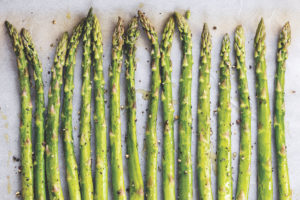The vegetable garden is in a spring shambles. But some parts of it are waking up all on their own. I can see from inside the house that the parsley has a new lease on life. And if we can just get out there and feed the asparagus, soon it will be feeding us.

Chuck Reese, editor of the Bitter Southerner, wrote a letter recently likening his publication to asparagus. It’s my favorite online magazine, with excellent stories and photographs that delve into what Reese calls “the duality of the Southern thing.” But it is just as surely about something my neighbors here on the Outer Cape understand: the curious contradictions of love of a place. At the moment, their online shop sells a T-shirt that says, “John Prine — Original Bitter Southerner.”
In his letter, Reese asked, “Do you know which crop is the greatest act of faith to plant?
“Asparagus.
“Can’t harvest it for three years without killing the plant or stunting its growth too soon. But if you tend it well for 36 months, it will give you food for up to 40 years.”
Gathering up our faith as we all are right about now, it is surely a good time to think about planting asparagus. And about starting independent publications. There’s plenty of tradition behind both endeavors — a history of the first in Eastham and of the second in Provincetown.
Here are two worthy ways to cook asparagus, once it is up.
Roasted Asparagus With Parmesan
for 4 servings
One bunch (about 1 lb.) asparagus
2 small shallots, minced
¼ cup grated Parmesan cheese
¼ cup panko
2 Tbsp. olive oil
Kosher salt
Heat the oven to 400° F.
Trim the woody stem ends off the asparagus. (Simmer them with onion for asparagus stock or throw them into the freezer with other trimmings for vegetable stock later on.) Wash the asparagus and set it on a clean tea towel to dry.
Spread the asparagus out on a baking sheet, toss it gently with the olive oil and kosher salt. Roast for about three minutes, then toss on the shallots, shake the pan once or twice to turn the asparagus, and roast for two or three more minutes, until it’s bright and just tender.
Remove the pan from the oven and switch the oven to broil. Scatter grated Parmesan and panko onto the asparagus, give the pan a good shake to distribute everything, and broil for a minute or two, until the cheese and panko are golden brown.
Blanched Asparagus With Sauce Gribiche
for 4 servings
One bunch (about 1 pound) asparagus
1 hard-boiled egg
2 cornichons
1 Tbsp. capers
1 Tbsp. Dijon mustard
1 Tbsp. wine vinegar
3 Tbsp. olive oil
1 Tbsp. minced parsley
1 Tbsp. minced tarragon, if you have it
Kosher salt and black pepper
Trim and wash the asparagus. Bring a skillet-full of salted water to a boil. Add the asparagus and simmer it for two minutes or until just tender. Remove the asparagus, first to an ice-water bath, then to a clean tea towel to dry.
Grate the hard-boiled egg into a small mixing bowl. Chop the cornichons (or a few bread-and-butter pickles) and add them to the bowl. Stir in the capers, mustard, and vinegar. Whisk in the olive oil.
When you’re ready to serve, mince the parsley and tarragon (or dill is good, too) and add the herbs to the sauce, then season to taste with a pinch of salt and few grinds of pepper.
Serve the cooled asparagus with big dollops of the gribiche.
A Tricky Match to Make
Asparagus is notoriously tricky to pair with wine. Part of the problem is its highly vegetal nature — that lovely green taste. But it also contains compounds that can make wine taste weirdly metallic.
A good rule of thumb is to go with a crisp, citrusy white wine that plays up the bright flavor of the vegetable. If your asparagus is prepared simply, say with butter and some shallots, I’d recommend a New Zealand sauvignon blanc, French Sancerre, or a Grüner Veltliner from Austria.
If you’ve made it richer and added umami, as with the Parmesan cheese or the sauce gribiche here, you might opt for an unoaked chardonnay. That’s what France is for, of course. But to expand your repertoire, try one from Oregon or Australia. Salud! —John Guerra
